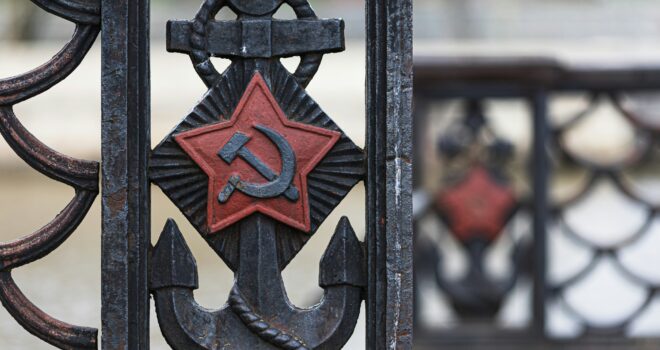Editor’s Note: On this day, August 20th, of 1968, the Soviet Union invaded Czechoslovakia and brought an end to the Prague Spring. May we pray for the souls of those who suffered and died as a result.
In her introduction to this volume, former Catholic Exchange editor Kristen Van Uden Theriault writes that she undertook this project “to ensure that the harsh truths of communism are not reduced to what Solzhenitsyn diagnosed a ‘poetry under a tombstone, truth under a stone.’” Her objective is “to give voice to a generation of Catholics whose testimonies have been repressed, ignored, or buried under the weight of time” (p. 7). In under two hundred pages, the author accomplishes her task, and her product benefits many.
This is a book that can easily be read by curious and capable high school students; assigned to college undergraduates who need broad historical perspective; studied by graduate students for its technical excellence in transcribing oral history; and enjoyed by anyone interested in the history of the Communist states of the twentieth century. It is especially a treasure for those looking down those avenues through the lens of the Catholic faith.
Before diving into the stories of those who faced Communism and suffered under its iron fist, Theriault ensures that readers have a basic understanding of the Communist ideology. In just a few sentences, she provides a great synthesis of the ideas that oppressed and slaughtered untold millions of people in the last century, and which continue to do so today in a few remaining Communist countries.
The fundamental operating principle of communism is the utter absence of God from human achievement. It proclaims that humanity can save itself: through science, ingenuity, economic prosperity, and social principles divorced from their ethical roots. That man is in control of his own destiny, has become his own god, a god who acts through the will of the proletariat and its keepers. And that religion, especially as embodied in the institutional churches, is an outdated myth that only serves to divide, impoverish, and enslave the people. (p. 15)
More practically, the author lays out the five-step “blueprint of oppression” used by dictators and Communist parties around the globe, especially as it relates to the Catholic Church. The first step is to “Outlaw the public worship of the Church;” the second step, “Round up the clergy and religious;” thirdly, “Seize and repurpose Church property;” fourth, “Control the Laity;” and finally, “Infiltrate” (pp. 4-5). While this process was used by Communist parties specifically, it is easy to understand that this is the same process employed by any totalitarian ideology present in the world.
For the sake of keeping the study manageable (and the book length, too), Theriault limits her scope to three geographic areas that fell prey to atheistic Communist regimes.
She begins with Cuba, one of the few remaining Communist dictatorships left in the world—and the closest to American soil. She focuses primarily on telling stories of los plantados—Cuban citizens who remained “planted firmly in their beliefs” as they made efforts to resist Fidel Castro’s reign of oppression (p. 38).
Next, the author examines Czechoslovakia, a central European country in which “atheism became the official state ideology overnight, thus relegating centuries of Catholic life to the funeral pyre of progress” (p. 76). The author illustrates the reality of Communist oppression specifically through the lives of two citizens who were born at about the same time as the Communist regime took power. Their stories highlight the youthful vigor that pervaded the Prague Spring of 1968 and the Velvet Revolution of 1988.
Finally, the author briefly examines the political and social climate in Communist Hungary, from where many faithful Catholics had to flee in the 1950s. Each of the stories is engaging, and Theriault captures the reader’s attention through the poignant picture she paints with her words.
Probably the most significant motif in this study is the sustenance on which resistors of Communism relied during the oppressive years. In disparate geographic areas, and in countries with slightly different manifestations of Communist rule, the immeasurable sources of strength for resistance were, without a doubt, the grace of the sacraments, orthodox Church teaching, popular devotion, and vibrant communities.
Resistance is often characterized by heroic outward-facing actions. But internal resistance—mental, spiritual—is the most important. It is the priority of the soul and the foundation of sanity in times of trial. The ultimate resistance is to hold on to your soul, to keep the Faith, and to die with the name of Christ on your lips, whenever the time comes. (p. 15)
Near the end of the book, the author again reveals her deftness in prosaic style, providing great spiritual insight into the image of the hammer and the sickle:
The hammer and sickle will always be symbols of oppression, atheism, human rights abuses, and societal destruction. But they are also the ultimate means of sanctification for millions of Catholics whose faith was tested. … When the glories of the utopian state disappeared, the shredded tatters of the Church remained. (p. 157)
Specifically, the author identifies several devotions that were important in holding together such tattered threads.
In Cuba, the presence of the Shrine of Nuestra Señora de Caridad was a source of inspiration and hope for faithful Catholics. Miraculously, it was never closed or destroyed by Castro’s regime, and those who emigrated from Cuba to the United States brought the devotion with them.
In Czechoslovakia, a live presentation of Jesus’ Crucifixion on Calvary and a candle demonstration on the Solemnity of the Annunciation (March 25th) in 1988 were instrumental in initiating the revolutionary moments that ended Communist rule in the country.
In Hungary, the Marian pilgrimage site at Csíksomlyó remained open for devotion throughout Communist state oppression. Each of these was a sturdy thread for binding up the wounds inflicted on the Body of Christ by the evil ideology.
While this book is valuable simply as a solid work of historical memory, its greater value is in causing readers to ponder the realities of the present and the future. While turning the pages of this study, the reader inevitably begins to see connections between the Communist regimes of the bygone era (except in the case of Cuba) and the terribly secular ideologies at play in politics, economics, society, and culture in our own present world.
Communism, atheism, false faith in this world. Or Catholicism, fidelity to Christ and His Church, eternity. This was the choice presented to Catholics then, is presented now, and will be forevermore under different names. (p. 12)
Faithful Catholics who are equipped with knowledge of Communism’s past can also be ready to stand against present ideologies that exhibit identical tendencies.
This book is an inspiration for those of us who desire to resist the sickle of Communism and who, even more, desire to be prepared when the sickle of the Lord’s harvest swings.
Editor’s Note: Kristen Van Uden Theriault’s book When the Sickle Swings is available from Sophia Institute Press.
Photo by Alexandr Popadin on Unsplash










